Video Rewind tells the behind the scenes stories from the video store era, one rental at a time! This month’s movie is “Bad Girls” (1994).
In 1988, Young Guns breathed new life into the Western genre. With its young cast of hip, rising stars including Brat Pack member Emilio Estevez, Kiefer Sutherland, Lou Diamond Phillips, and Charlie Sheen, the film struck a chord with younger audiences, racking up an impressive $46 million at the box office. A sequel followed two years later, along with Kevin Costner’s Best Picture winner Dances With Wolves, officially announcing the return of the Western to mainstream audiences. The Western revival would peak in 1992 with another Best Picture winner, Clint Eastwood’s Unforgiven.
The box office hit Tombstone starring Kurt Russell and Val Kilmer would follow in 1993, and Kevin Costner would revisit the Old West again in 1994’s Wyatt Earp. But another film lassoed the Western trend in the early 1990s that looked a bit different from the other, male dominated movies. Four women stood tall on the poster, donning cowboy hats and holding guns as the low, orange sun set behind them on a dusty, desert landscape.
These women, prostitutes of the Old West, were the new gunslingers in town in 1994’s Bad Girls.
Tamra Davis worked in an apprentice position in the early 1980s at American Zoetrope, the film production company founded by Francis Ford Coppola and George Lucas. It was during the tumultuous production of the box office disaster One From the Heart where she got an up close look at Coppola’s directing style and really learned the business of filmmaking. After graduating from Los Angeles City College, Davis spent the rest of the ’80s directing music videos for Depeche Mode, The Smiths, The Bangles, Sonic Youth, and others. Her feature film directorial debut came in 1992 with Guncrazy, a crime-romance that earned Drew Barrymore a Golden Globe nomination, and course-corrected her troubled career.
Davis’s sophomore film would be Bad Girls, a female-centric Western written by Yolande Turner and Becky Johnston, the Academy Award nominated screenwriter of The Prince of Tides (1991).
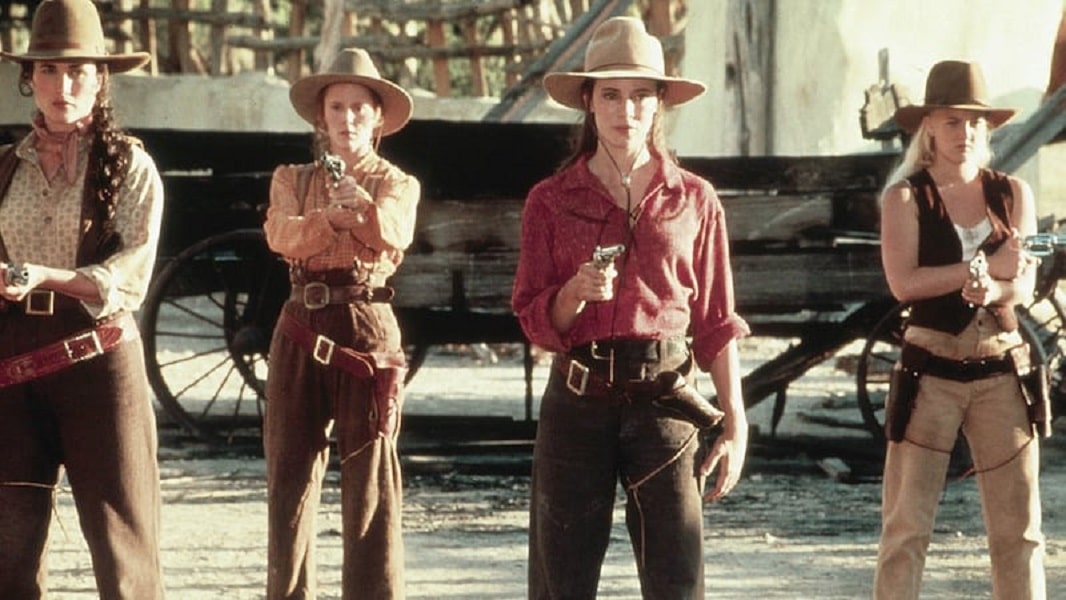
What started as a smaller scale, $6 million production quickly ballooned in both scope and budget when producers André Morgan and Albert S. Ruddy made a deal with Twentieth Century Fox. The budget was upped to $16 million and the studio ordered name actresses to lead the film.
The film’s potential went through the roof, and Bad Girls quickly became a high profile picture.
Davis was reunited with her Guncrazy star, Drew Barrymore. Barrymore had long been a household name since being too adorable for words as Gertie in Steven Spielberg’s decade defining phenomenon, E.T. (1982). In addition to her film roles, stints in rehab for drinking kept the troubled Barrymore in the headlines until the early 1990s.
Madeleine Stowe was on Hollywood’s A-list after her big year in 1992, having starred in the box office hits Unlawful Entry and The Last of the Mohicans. Former model Andie MacDowell turned heads in Steven Soderbergh’s sex, lies, and videotape and charmed audiences in Green Card (1990), both roles earning her Golden Globe nominations. MacDowell was also in the midst of the critical and box office success of 1993’s Groundhog Day opposite Bill Murray.
Rounding out the cast is Mary Stuart Masterson, recognizable to audiences from Some Kind of Wonderful (1987), Fried Green Tomatoes (1991), and was enjoying a sleeper hit in 1993 alongside Johnny Depp in Benny & Joon.
With four of Hollywood’s hottest actresses, Bad Girls quickly garnered a lot of buzz when production began in late June of 1993.
Filming started at the Red Hills Ranch in Sonora, California.
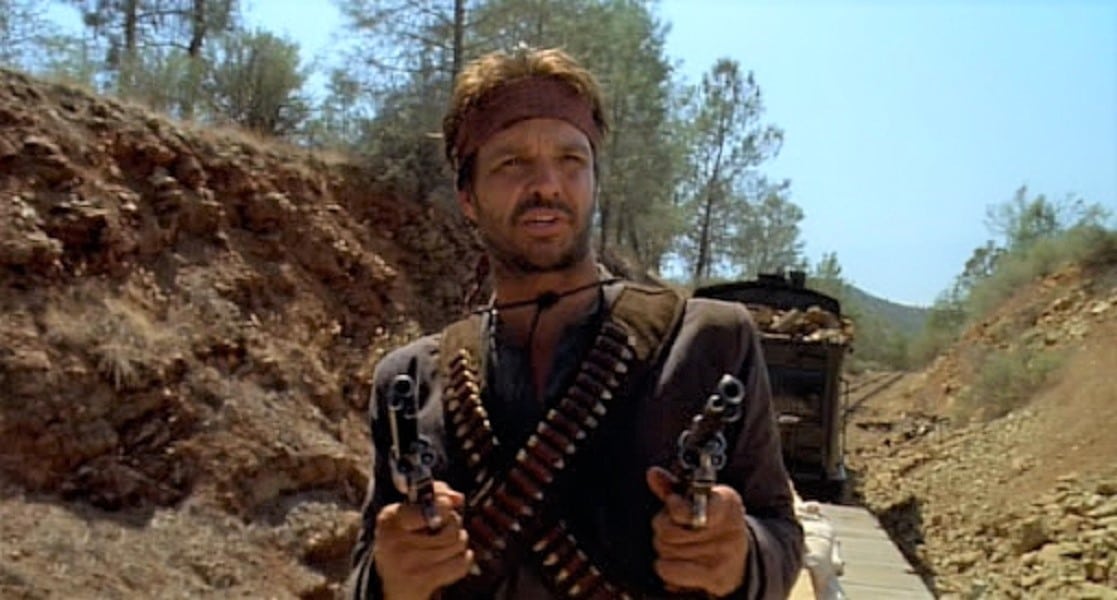
This was the same location used in Back to the Future Part III and Little House on the Prairie (the ranch was destroyed in 1996 in a brush fire caused by a lightening strike).
Just days prior, Davis reportedly was handed an extensive rewrite of the script, leaving the cast very little rehearsal time with the new material. After the first couple of weeks production fell behind schedule, and Twentieth Century Fox didn’t like what they were seeing in the dailies. Word was that Davis wanted the Wild West seen through a feminist lens, while the studio wanted to see more traditional Western action in the style of Young Guns.
By mid July, Davis was removed as director of Bad Girls (coincidentally, in June Kevin Jarre was removed as director of Tombstone).
Producers Morgan and Ruddy said the move was due to “creative differences,” the old Hollywood motto to smooth over any problems and avoid controversy. Madeleine Stowe felt the tension on set, recalling, “I remember thinking that there was something that wasn’t quite right. There was this free-floating anxiety on the set. It was weird. And then it fell apart.” But Stowe was also aware of the pressure Davis was under from the studio, and defended her by adding, “there is no director, given the kind of production she was given, who could have come up with what they wanted.”
Davis would later get a call to helm a comedy about a goofy man-child starring an up and coming Saturday Night Live cast member named Adam Sandler. Billy Madison would go on to become a cult classic, as would Davis’s next directorial effort in 1998, Half Baked.
Production on Bad Girls was halted and re-scheduled to resume in late August.
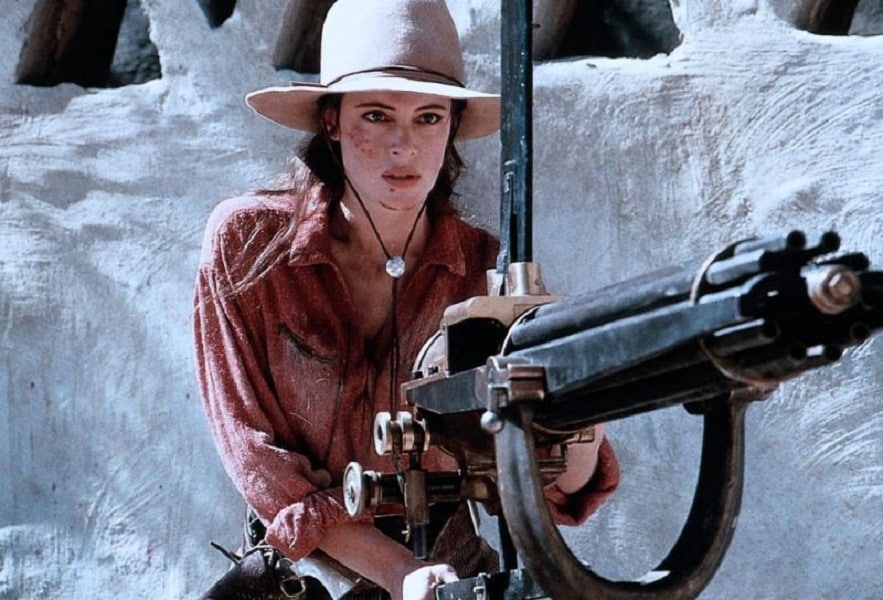
In the meantime, Lynda Obst was brought on board, the producer who partnered with Debra Hill to produce such films as Adventures in Babysitting (1987) and The Fisher King (1991). Obst also helped develop the script that would become Flashdance in 1984, and she gave Bad Girls a much needed feminine presence on set. Her hire was a welcome addition to the team, especially when the studio hired Ken Friedman to rewrite the script and Jonathan Kaplan to replace Tamra Davis as director (Friedman and Kaplan previously collaborated on 1983’s Heart Like a Wheel).
Kaplan was a capable hire.
Studying under cult film super-producer Roger Corman in the 1970s, Kaplan directed Jodie Foster to an Academy Award in 1988’s The Accused and delivered a box office hit in 1992 with Unlawful Entry, starring Bad Girls lead Madeleine Stowe. Speaking to Film Journal, Kaplan agreed to bring “more action and traditional western elements” to Bad Girls.
Any aspect of the Davis version seemed harder and harder to find as the project switched hands and changed in overall vision. Kaplan and Friedman did, however, take input from the four female leads. “I was pretty adamant about some of the things we wanted to keep,” said MacDowell.
As the script was re-written, the budget was raised to about $30 million, new locations were sought, and the four leads were sent off to cowboy camp.
Both Stowe and MacDowell owned horses and were exceptional riders, but none of the women received proper weapons training or lessons in how to perform like a cowgirl.
Under the tutelage of stunt coordinator Walter Scott, a veteran of the business who worked on over 75 films including Dirty Harry and the Back to the Future trilogy, the women learned to ride horses (Barrymore’s horse was named Bon Jovi), and were trained to do a lot of their own stunts. These are things in filmmaking that are largely only done by men.
While the feminist leaning version Tamra Davis had envisioned was turning into a more male friendly, traditional Western at the studio’s request, the masculine training and physicality of the performances were a step forward for women at the time.
Producer Lynda Obst summed it up by saying Bad Girls is “much more in the tradition of Sergio Leone. This movie is an homage to movies, not to history.”
Production re-started on August 26 in Brackettville, Texas, about one hour from the Mexican border. Filming took place at Alamo Village, a film set built in 1957 for the John Wayne film The Alamo. Over a dozen movies have been filmed there, including the hit 1988 TV mini-series Lonesome Dove, but the site has been closed, perhaps permanently, since 2018.
Andie MacDowell noticed the changes in the script, saying, “we got a lot more action.”
Stowe noticed as well, but recalled the production changes in a less than positive way saying, “it was almost like two different movies,” adding “it was a terrible, confusing time.”
Regarding the tedious 2 month shoot in Brackettville, Dermot Mulroney observed, “it’s real dusty, flat and hot in west Texas, there’s not much to see in that terrain. But who needs beautiful vistas when you have beautiful co-stars?” Well said, Dermot, well said.
The film opens at a saloon that doubles as a brothel where Anita, Cody, Eileen, and Lilly all pull double duty as servers and prostitutes. Anita (Mary Stuart Masterson) is upstairs entertaining a man on his birthday. The man hoots and hollers and oinks like a pig as he playfully chases Anita around the room until he is overcome by sexual desire, frantically kissing her arm and ready to do the deed. When the man gets upset that Anita won’t kiss him (she’ll do anything but kiss, a promise she made to her dead husband), he slaps her across the face as she runs from the room onto the balcony.
Serving guests downstairs is Cody (Madeleine Stowe), who shoots the man for threatening to strike Anita again.
And just like that, within 5 minutes, Bad Girls is off and running.

Eileen (Andie MacDowell) and Lilly (Drew Barrymore) come running in the direction of the shot and an angry, religious mob round the women up (“Harlots Are Satan’s Children” and “Stop Demon Alcohol” their signs read), and prepare to hang them for murder and living a life of sin. The women narrowly escape, looking fierce riding through town and kicking up dust as they speed away on horseback to get the heck out of Dodge (or in this case, Echo City, Colorado).
Barrymore looks especially badass in this scene, and Stowe is a sight to behold as she escapes the noose while riding her horse with her hands tied behind her back.
The women meet a man named McCoy (Dermot Mulroney) while on the run who informs them that they are now wanted women. He hands a WANTED flier to Cody with a drawing of her face on it, declaring her the Honky Tonk Harlot. Thinking of ways to escape the area, Anita mentions a patch of land in Oregon that was left to her by her deceased husband, she just has to claim it.
Anita suggests the idea of starting a sawmill business on the land, offering “we sold our bodies, why can’t we sell some wood?” Eileen and Lily mostly laugh off the idea, but Cody says she can fund the business with her life savings. Anita and Cody exchange a warm smile.
At this point in the film it’s clear to see that Barrymore and MacDowell have a wonderful onscreen chemistry.
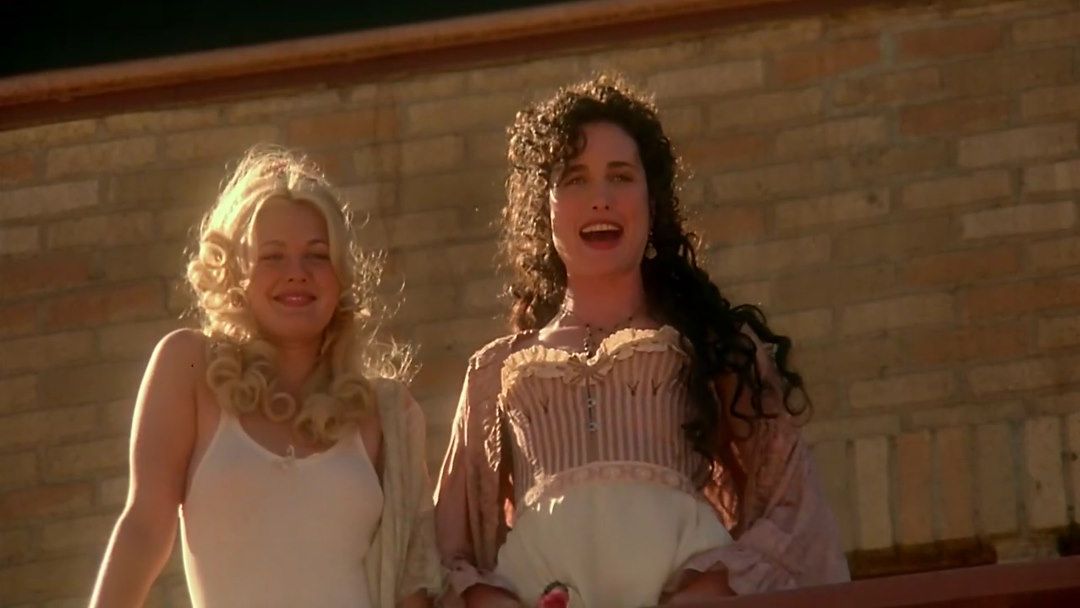
Barrymore, by far the youngest among the women, said she gravitated toward MacDowell during filming, saying the actress was always so sweet and nice to her.
The other to of the group, Anita and Cody, share moments of deep connection. Perhaps it’s the strong bond of womanhood born out of a shared rough life that Anita and Cody relate to in each other. Or perhaps it’s something more, as their bond feels different than the bonds they share with Eileen and Lilly. Perhaps it’s love that Anita and Cody share. The subtext is there for both to be true, and if it’s the latter that you take away from the film, then Bad Girls was a step forward in more ways than one.
Cody goes into town to buy a nice dress to go to the bank to withdraw her savings. “I think a woman like you would be better off shopping somewhere else,” responds the clerk at the dress shop. Cody grabs the man by the shirt, yanking him back around and whipping out her gun to shove in his face in a split second.
It’s a fantastic moment for Stowe, who continues to prove that this cowgirl is as tough as any cowboy in the Old West.
Needless to say, the clerk helps Cody find a dress. But all doesn’t go well for Cody. After she takes out her money she gets caught up in a bank robbery by Kid Jarrett (James Russo) and his gang, an old lover of Cody who steals her money and says, “come find me.”
All of the action centers around Madeleine Stowe.
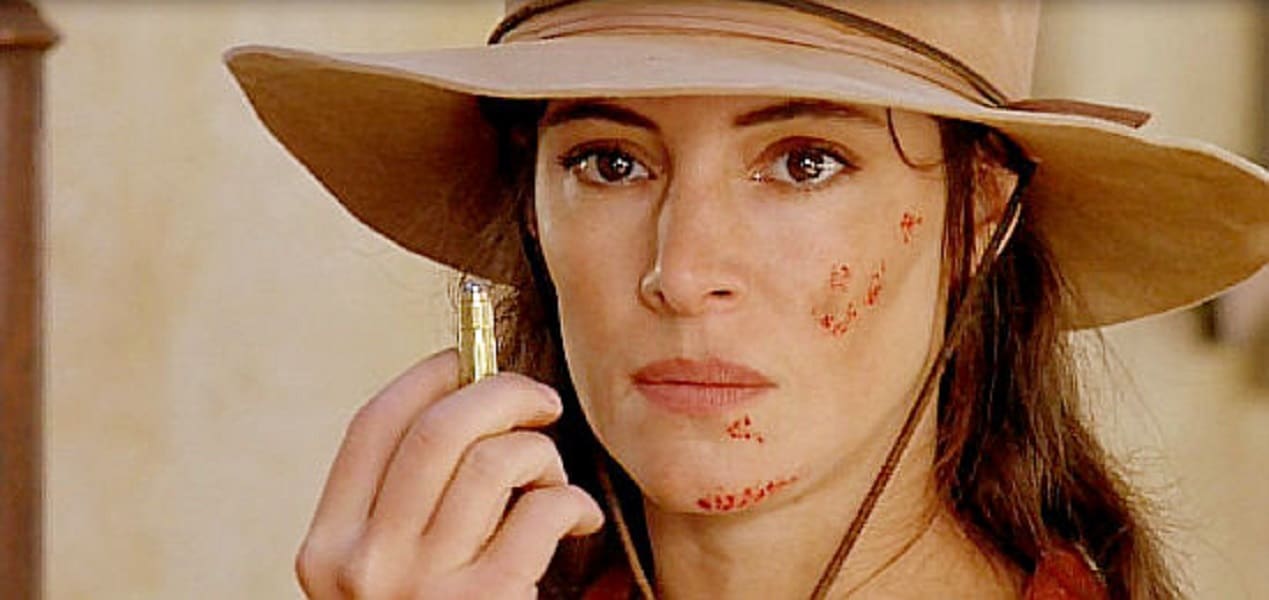
She possesses an elegant toughness, a quiet strength that comes across both in her deeply brown eyes and in Cody’s zero tolerance for bullshit. She’s the authority of the group, the leader, and for good reason.
As for the rest of the group, MacDowell is the Southern Belle charmer, Masterson is the dreamer, and Barrymore is the wild one.
Barrymore is absolutely striking in the midst of the Western backdrops, her blonde hair and bright face giving the hot, Western sun a run for its money. Whether she’s firing a gun or smoking a cigarette, Barrymore looks like she’s having a blast playing Lily, and it’s just as fun for the viewer watching her.
Cody does find Kid Jarrett to get her money back, and the confrontation leaves her whipped, beaten, and left for dead on the side of the road. She is found unconscious on her horse by McCoy, who has developed a strong affection for Cody. Very concerned, McCoy quickly brings her into the nearest town to see a healer.
It’s easy to see Mulroney’s McCoy as “the man who saves the woman,” and although there’s an argument to be made there, it may be too simplistic a reading of the situation.
The traditional Old West was full of more men wandering the terrain on horseback than women, and in this way it could be interpreted that McCoy is not the man who the women need, he’s the man who sides with them. McCoy could be seen as the early signs of a new generation coming up that views women as, while not necessarily equal yet, more like actual human beings. Further negating the “rescued by a man” take on the sequence, the healer nursing Cody back to health is a woman.
In the end, Anita finds out that because she’s a woman she cannot lay claim to the land her husband left behind. While she is rightfully very upset, Anita rejoins the other women as they ride off into the sunset to partake in the Klondike Gold Rush, looking to get rich.
According to Masterson, the ending of Bad Girls had to be re-shot because test screenings of the film showed the women going their separate ways, triggering negative comments from the audience. Added Stowe, “originally, when the film was tested, audiences said, ‘Where are the women going?'”
Barrymore said the cast experienced many “moments” together, both as artists and in their personal lives.
She also said her time on Bad Girls changed her life, having “worked with powerful, strong, and intelligent women for 5 months and pulling together. Now we have a film that shows it.” Mulroney echoed this sentiment saying, “they are strong, central figures without relying on men in any way. It was always important that they take care of business by coming together.”
Despite the triumph of four women leading a big studio Western, the cast ultimately didn’t see Bad Girls as a good film.
Barrymore recalls the film as one she’s ” just not into,” Stowe said, “I think it’s just fun entertainment, I cannot say that it has anything profound to say,” and later called it “a terrible movie.” As for the strong females of the Wild West advertising campaign, Masterson said, “unfortunately, from the poster, it looks like ‘Charlie’s Angels.’”
Bad Girls opened in theaters on April 22, 1994, ending the weekend at the top of the box office with a $5 million debut.
Its #1 opening pushed another Andie MacDowell movie, Four Weddings and a Funeral in its 7th week of release, out of the top spot and into number two. Bad Girls would end its theatrical run earning $15.2 million, only making back roughly half of its budget. Released on VHS later that year in October, the film found moderate success spending 8 weeks in the top 30 of Billboard‘s Top Video Rentals chart. Bad Girls would go on to make many “Worst of” lists, including Jeff Simon of The Buffalo News, who at least recognized the film’s entertainment value saying, “Bad Girls, in fact, was so awful that it was almost good.”
The intention was there, the message was there, it just didn’t translate into a full length feature film.
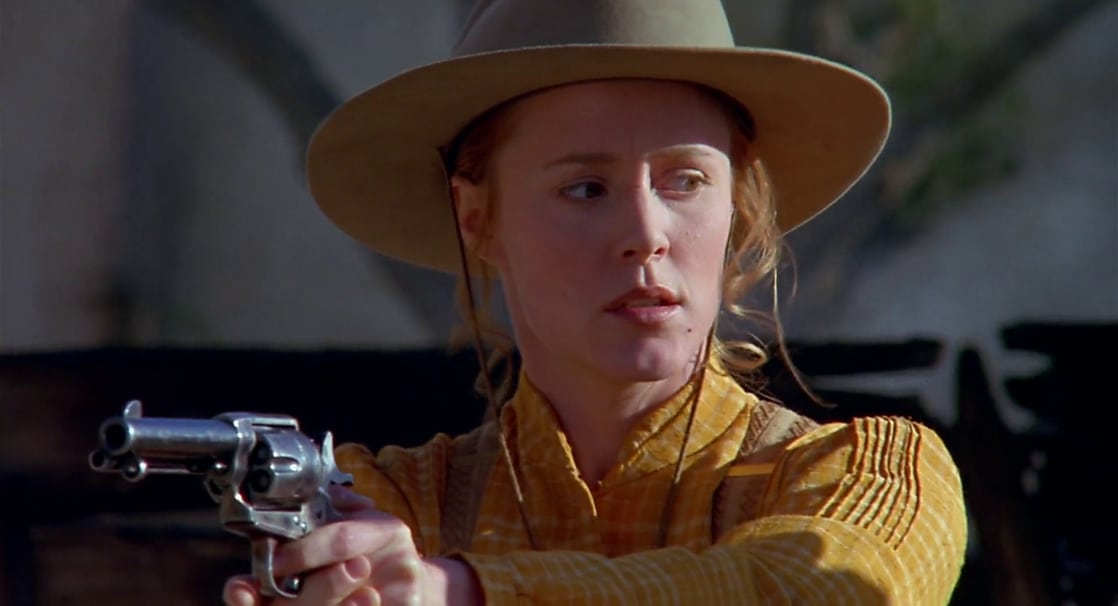
This reading of the film is summed up in the trailer put out by Twentieth Century Fox to promote the film. The Bad Girls trailer promises everything the film tried to do, but failed to fully deliver on (seriously, go watch it, it’s a great trailer).
Instead, the film is a campy, big popcorn spectacle filled with big open skies, dusty saloons, the sound of boots on plank board sidewalks, and horses splashing through rivers.
BAD GIRLS is a dream of the Old West, full of slow talking tough guys and even tougher girls. Barrymore said the film has a 90s purpose, but done in a traditional Western style. #videorewind Click To TweetThe studio over-thought things.
By shoehorning in more action and relying heavily on formulaic Western tropes to help capture the male audience, any true feminine identity the film once had was heavily diluted. But a Western fronted by four women was new territory in 1994, a risky film for any studio to take on. Sam Raimi’s The Quick and the Dead starring Sharon Stone came out the following year, proving Bad Girls wasn’t just a fluke.
It’s a miracle these films were made at all, and as flawed as they are, their importance should be celebrated. If the guys can make big, goofy action flicks in any genre they want, then the girls can get in on the action as well.
Mixed results aside, Bad Girls proves this, both in preparation off the screen, as well as performance on the screen. As Andie MacDowell observed, “I loved seeing my girlfriends riding off into the sunset.”


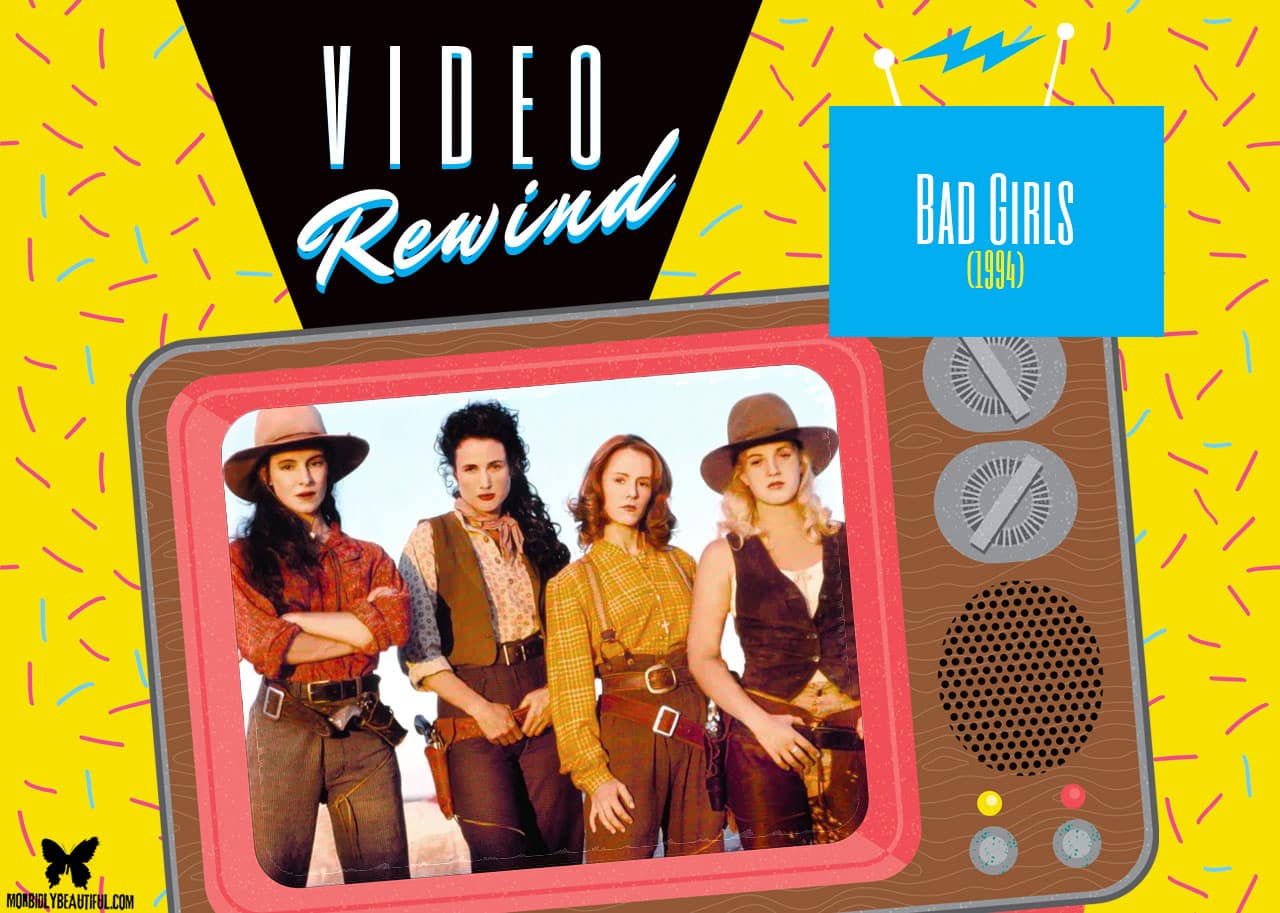
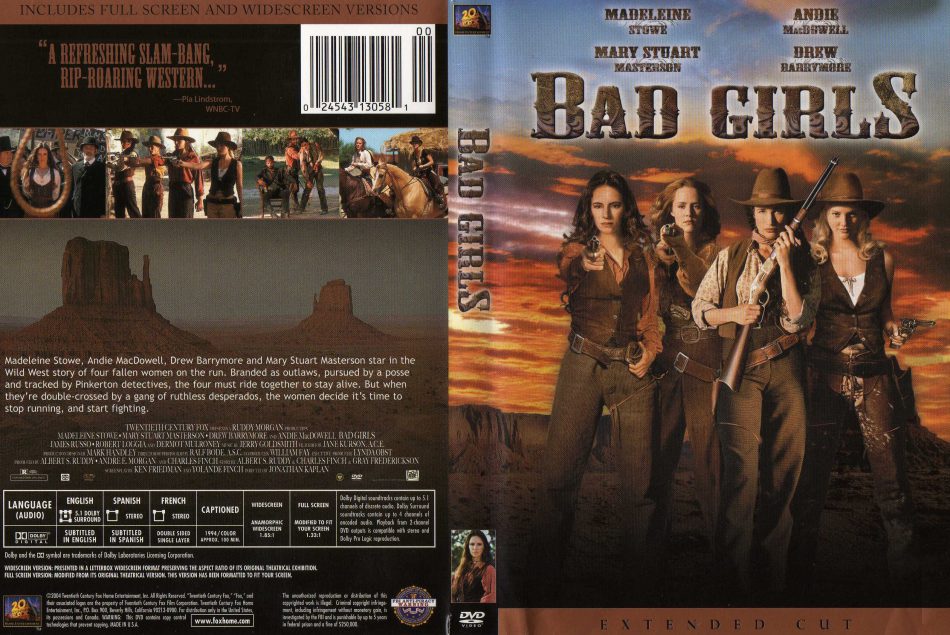
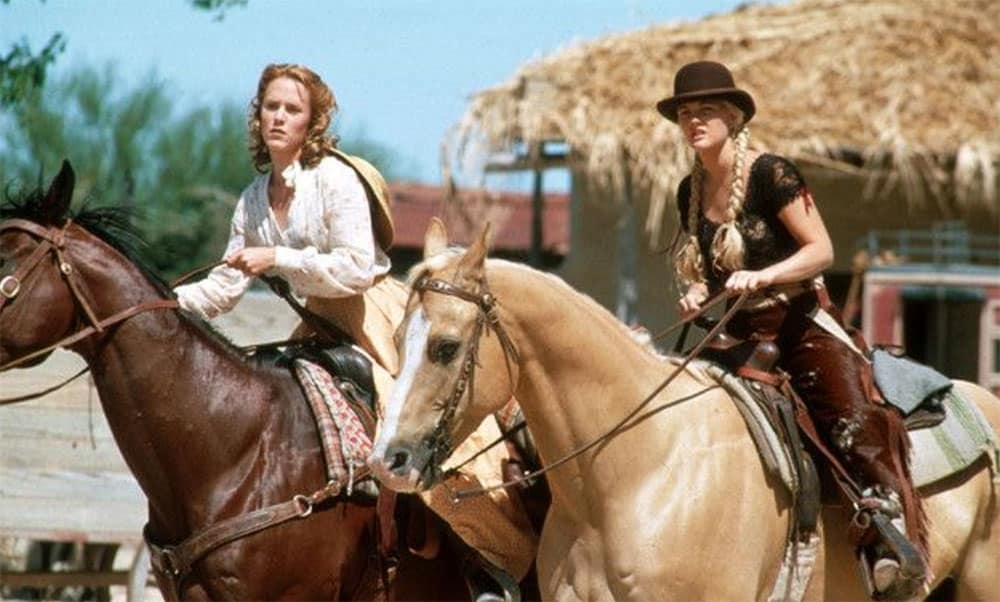
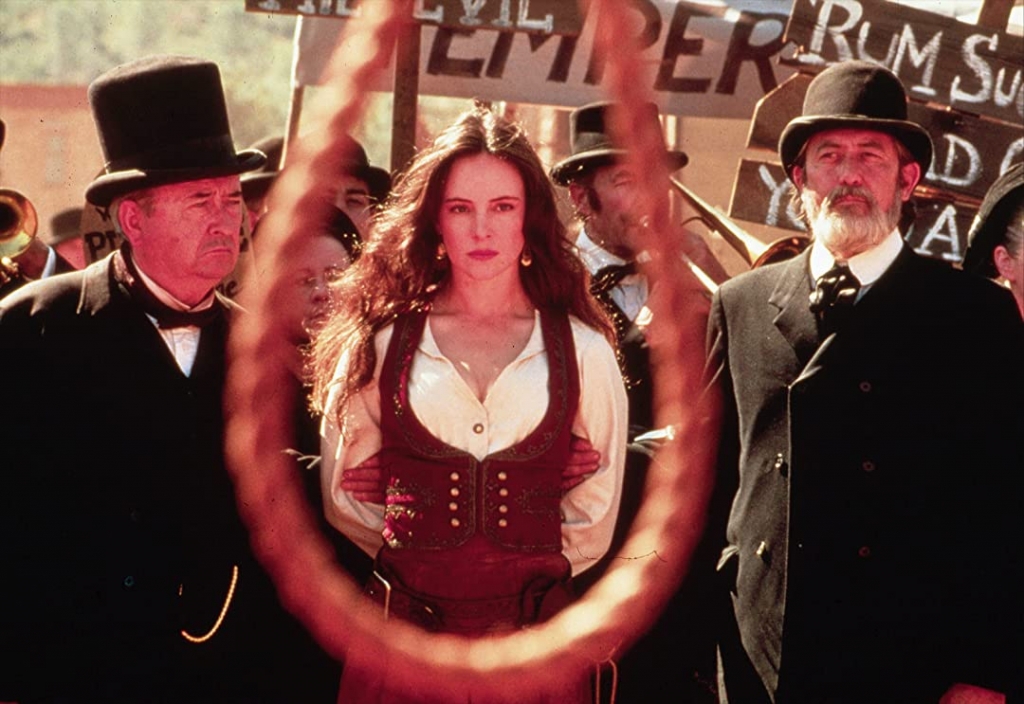
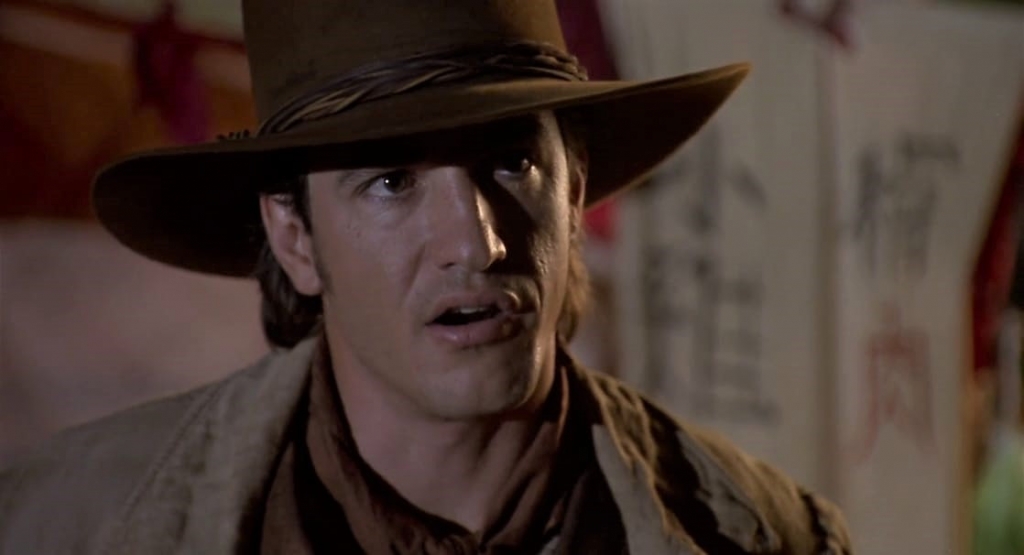
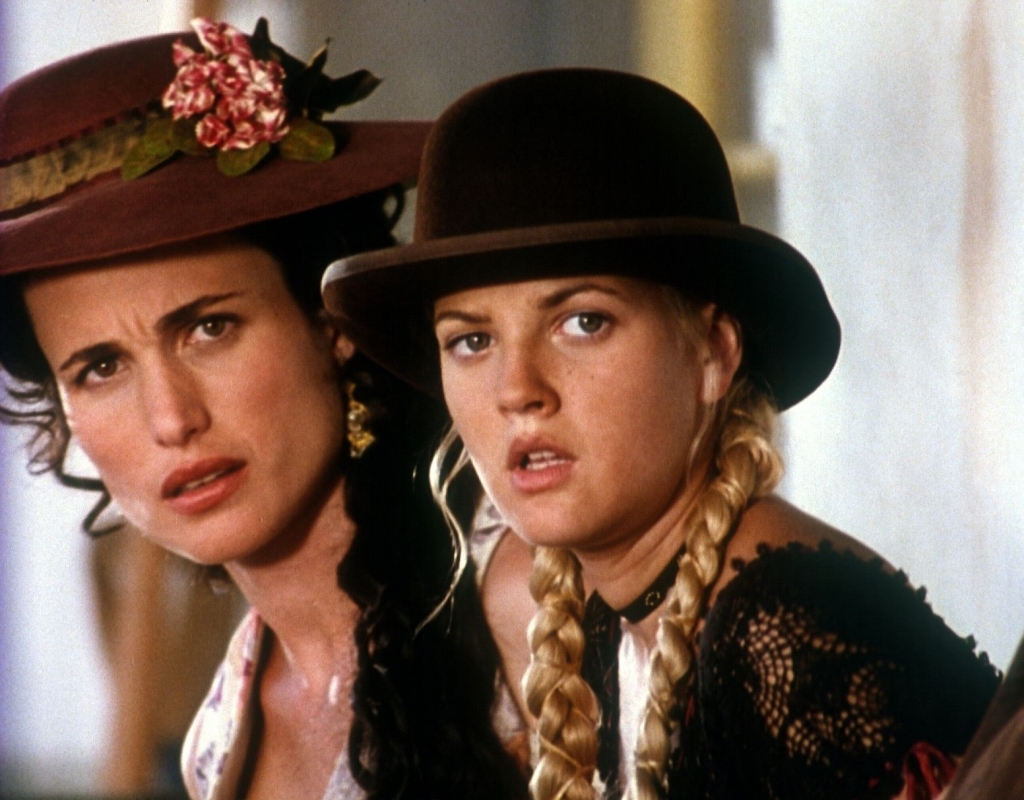

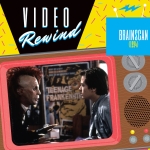










Follow Us!